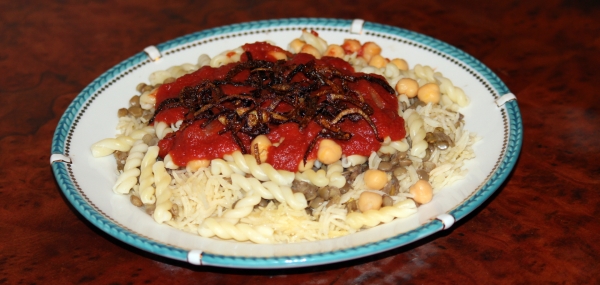
Egyptian Vegetarian Koshari is an comfort food found both in street stalls and restaurants. The ingredients are rather unassuming and seemingly incompatible (rice, pasta and lentils together?). But they conspire to create a surprisingly harmonious and unique taste that will please and satisfy ardent vegetarians and incorrigible meat eaters alike.
Koshari (Arabic: كشرى) is an essential and beloved dish in Egypt. It is on the menu in nearly all restaurants; there are whole restaurants that sell only Koshari and it is sold by innumerable street vendors who are often referred to as "Koshari Men." While it is a quintessential Egyptian dish, many of its ingredients did not originate there. To those who have not tried the dish, the list of ingredients, and what one would imagine they taste like together is nearly culinarily incomprehensible. Somehow the strange combination works despite what one might think. Koshari has very basic ingredients. It is a food enjoyed by all strata of Egyptian society, but because the ingredients are so inexpensive and the dish is so fulfilling it is held in particular high regard by laborers and workers who exist on modest means. In many places in the world, in part due to the expense of meat and fish, non-vegetarian meals are often considered prestige or special due to their cost. Koshari is normally completely vegetarian (indeed vegan), but due to the unique combination of ingredients, meat eaters are likely to end up happily satiated after a single serving. The basic ingredients are rice (long-grain Basmati being favored), brown lentils (easy to prepare and they don't need pre-soaking), pasta (any kind will do), garbanzo beans (chick peas), lightly spiced tomato sauce and fried onions. The tomato sauce is mildly spiced with hot pepper flakes or cayenne powder. Nearly all the constituent parts (rice, lentils and sauce) are enhanced by sautéing onions in the pans beforehand. A healthy dash of Arabic 7 spice to the sautéing onions just before the other ingredients are added helps things along.
While it does require several cooking pots, preparation is extremely easy. Almost all of the ingredients are cooked separately and are assembled just before eating. Perhaps the most difficult task is caramelizing the onions for the final topping. Apparently (I haven't been to Egypt yet), watching Egyptian street vendors assemble an order of Koshari is half the fun. A deft Koshari man can assemble the dish in mere seconds with a rhythmic and percussive precision that is a marvel to behold. Koshari is assembled in layers. Start with a bed of rice, festoon some lentils over the rice, add pasta, then garbanzo beans. On top of these layers, cover with the tomato sauce and top everything off with some caramelized onions.
Baharaat (Arabic: بهارات) or "Arabic 7 Spice" is the only ingredient you are unlikely to find in a regular grocery story. Any Middle-Eastern grocer will carry it. I have provided a recipe below to make your own Arabic 7 spice. Although there are variations, black pepper, nutmeg, cumin seeds, coriander seeds, cardamom, cloves and cinnamon are commonly used.
Ingredients:
For the Koshari:
- 1 cup brown lentils
- 2 cups Basmati rice
- 1/2 pound pasta
- 1 15-ounce can tomato sauce
- 1 15-ounce can crushed tomatoes
- 2 cans garbanzo beans
- 1 large or 2 medium onions sliced thinly
- 3 cups vegetable stock
- Olive or vegetable oil
- Arabic 7 Spice
To make your own Baharaat (Arabic 7 Spice):
- 2 tablespoons black pepper
- 2 tablespoons paprika
- 2 tablespoons cumin seeds
- 1 tablespoon coriander seeds
- 1 tablespoon cloves
- 1 teaspoon ground nutmeg
- 1 teaspoon ground cinnamon
- 1/2 teaspoon ground cardamom

Preparation and Presentation:
For the Baharaat (Arabic 7 Spice):
- Roast the cumin and coriander seeds in a shallow frying pan on medium heat. Turn frequently until they are light brown.
- Alternatively, roast the seeds in an oven. This method offers more control. Toaster ovens are particularly good for this task.
- Let roasted spices cool. (This is important, you might damage your grinder grinding hot spices (as I did years ago!).
- Place all the spices in a grinder and grind to a fine powder. If you use your favorite coffee mill for this, after you have finished and removed the spices you can grind to a powder a small handful of rice to clean the coffee mill unless you prefer to have spicy coffee!
Note: if you have several pots you can cook the following simultaneously.
For the Lentils:
- Pour a small amount of lentils on a flat surface and inspect for debris like little stones, put the clean lentils in a bowl.
- Saute 1/4 of the onions in the bottom of a pot until they are translucent.
- When the onions are soft and translucent, add 1 teaspoon of Arabic 7 spice. Continue cooking for another minute or so to release the spice flavors.
- Add water and cleaned lentils to the pot.
- Bring the pot to a boil and then reduce to a simmer.
- Add water if needed.
- Cook lentils for 20 to 30 minutes testing them until they turn soft but not mushy.
- Salt to taste.
For the Rice:
- In a pot saute another 1/4 of the sliced onions until they are close to being translucent.
- Add rice and stir continuously until the rice starts to turn opaque.
- Add 1 teaspoon of Arabic 7 spice. Continue cooking for another minute or so to release the spice flavors.
- Add vegetable stock to pot.
- Bring to a boil, cover the pot and reduce heat to low.
- Cook rice for 15 to 20 minutes until done.
For the Pasta:
- Cook pasta according to the package instructions.
For the Garbanzo Beans:
- Drain the beans and rinse them in water.
- In a small pot cook the beans for a few minutes in sufficient water to just cover the beans in the pot.
For the Sauce:
- Pour the crushed tomatoes and tomato sauce in a pot.
- Heat the sauce to a slight boil and add either chili flakes or cayenne powder to your preference. Mildly spicy is perhaps better for this recipe than super hot.
- How long you simmer the sauce depends on your taste. The longer it simmers the smoother it will taste, the shorter it simmers the more fresh and raw it will taste.
For the Onions:
- In a small frying pan or small pot, caramelize the remaining onions. Use sufficient oil to cover the onions. Use the lowest heat possible that still results in the oil bubbling. This will take a long time, 10 minutes or longer. Patience is required. Note that you should remove the onions when they are not fully caramelized because they will continue to deepen in color.
- Drain the onion of oil. If you wish you can lower the oil content by pressing them with paper towels.
Assemble the Koshari in the following order:
- Rice
- Lentils
- Pasta
- Garbanzo Beans
- Tomato Sauce
- Caramelized Onions
Enjoy!
;Recipe by T. Johnston-O'Neill








